
Bee Fly
Staurostichus …Bee flies gain their common name from their fat, fuzzy bodies and their hovering style of flight. But the shape of its proboscis betrays it as a fly - as would its single pair of wings, if they were motionless. These flies were one of the most frequent visitors to the teatree flowers.

Bee Fly
Staurostichus …this one has landed and is eyeing off the flower and its contents.

Bee Fly
Staurostichus …down to work! The fly sweeps the floral bowl with its long proboscis, sucking up nectar. Those wings almost never stop beating, even when the fly is at rest.

Flesh Fly
Sarcophaga…Now this is a more normal looking fly. Definitely just one pair of wings. And it’s a rather attractive example - particularly, if you’re a Hawthorn supporter! The three parallel black stripes on its back place it in the family Sarcophagidae.

Flesh Fly
Sarcophaga…The common name ‘Flesh Fly’ reflects the fact that the larvae of several members of this family develop in cadavers and carrion. The adults are found in the same locales, depositing their larvae and gaining nutrients for egg production from the products of decomposition. Probably not your favourite insect!

Flesh Fly
Sarcophaga…The adults are often found in more pleasant places - at flowers, satisfying their own energy needs by eating nectar. They use the same instrument as the bee fly, the proboscis.

Signal Fly
Duomyia…some signal flies wave their wings back and forth. This type lifts its legs up and down to attract the attention of mates.

Signal Fly
Duomyia…but these flies were preoccupied with feeding rather than mating.
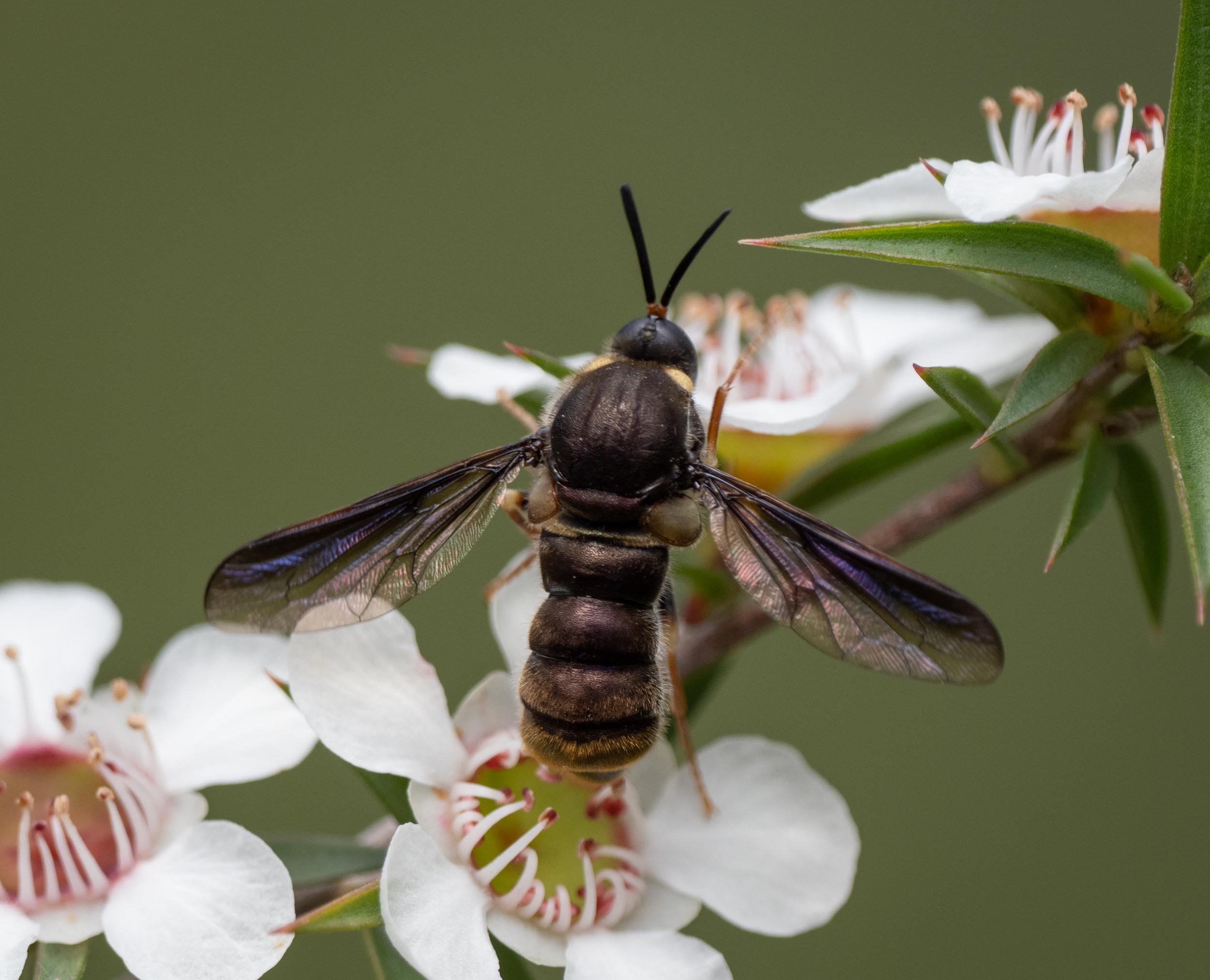
Small-headed Fly
Mesophysa…a very strange looking fly. The tiny head is dominated by the large eyes.
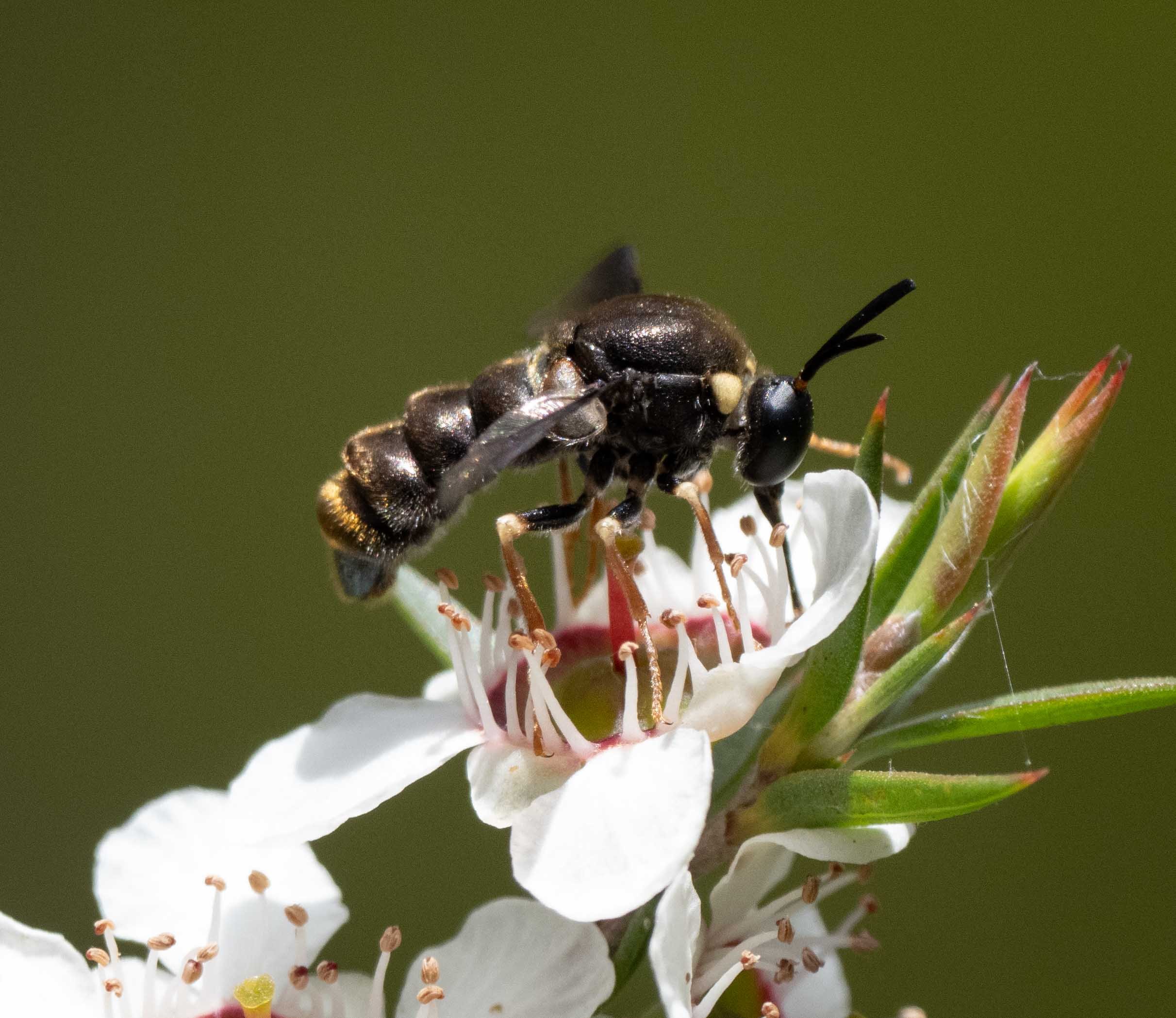
Small-headed Fly
Mesophysa…a side view of a feeding fly shows those huge eyes to good effect. The larvae of these flies are internal parasitoids of mygalomorph spiders - including funnel-web and trapdoor spiders.

Bristle Fly
Senostoma…these large, bristly long-legged flies are often seen feeding on flowers.

Flower Wasps
sub-family Thynninae…The male carries the smaller, flightless female around, coupled end to end. He pauses occasionally to allow her to feed on nectar. We saw at least 4 different species of this sub-family, which is taxonomically poorly resolved. We called this one species 1.
Click here for more details about this group.

Flower Wasps
sub-family Thynninae…species 1. The male is taking the opportunity to feed, while the female hangs off the end of his abdomen.

Flower Wasp
sub-family Thynninae…species 2, a different species of flower wasp. The female is markedly smaller than the robust male in this case.

Flower Wasp
sub-family Thynninae…we sighted a single female low down on the tea-tree bush. We suspect she was dropped by a male of species 2.

Flower Wasps
sub-family Thynninae…species 3. The male is about the same size as in species 2, but the female is much larger.

Flower Wasp
sub-family Thynninae…species 4. Same sub-family as the flower wasp species 1-3, but this one is tiny.

Flower Wasp
sub-family Thynninae…species 4. This one fits neatly inside the floral cup.

Flower Wasp
sub-family Thynninae…species 4 approaching the teatree bush

Spider Wasp
Calopompilus species 1…spider wasps feed their growing larvae paralysed, but still living spiders. The female stings a spider, carts it back to her burrow and places it in one of the cells, housing a single larva. As it grows, the larva gradually ingests the spider.

Spider Wasp
Calopompilus species 1…nectar in the teatree flowers supplies the adult spider wasp with its energy needs.

Spider Wasp
Calopompilus species 2…we sighted at least 3 species of spider wasps on the tea-tree flowers.

Spider Wasp
Ctenostegus?…This spider wasp was very active, pausing only briefly on the flowers to take nectar.

Spider Wasp
Ctenostegus?…It had a distinctive, black and white striped abdomen and large spines on the mid and hind legs.

Gasteruptiid Wasp
Gasteruption…This family of wasps has an extravagantly-elongated abdomen. The ovipositor, here marked with a white tip, is also a sight to behold. Coming in to land…

Gasteruptiid Wasp
Gasteruption…busy feeding on nectar. We sighted at least 3 different species of this strange wasp genus.

Gasteruptiid Wasp
Gasteruption…a male, judging from the lack of an ovipositor.

Gasteruptiid Wasp
Gasteruption…yet another species of this genus - with an outrageously long ovipositor!

Digger Wasp
Podagritus…a much smaller wasp, which provisions its developing larvae with stung, paralysed flies. Read all about it in Kerri’s post from last Spring.

Digger Wasp
Podagritus…here seen feeding on nectar from the teatree flower.

Hatchet Wasp
Hatchet Wasp…an extraordinary, small wasp. It continually beats its hatchet-shaped abdomen up and down as it takes nectar from the flower.

Hatchet Wasp
Hatchet Wasp…these wasps also have an unusual life history. Their larvae are parasitoids of mygalomorphs, including funnel-web and trapdoor spiders.

Masked Bee
Hylaeus…a very small, hairless bee that looks more like a wasp.

Masked Bee
Hylaeus…it is small enough to gain ready access to the nectar in the teatree flower, pushing aside the stamens.

Masked Bee
Hylaeus…females ingest collected pollen and carry it back to the nest in their crop together with the nectar.

Euhesma Bee
Euhesma…another tiny bee, these were one of the most common insects on the teatree flowers. The lower bee can be seen lapping up nectar from the floral bowl with its tongue.

Euhesma Bee
Euhesma…like Masked Bees, the female Euhesma transports the pollen and nectar back to the nest in its crop. They live solitary lives, nesting in a burrow in the soil.
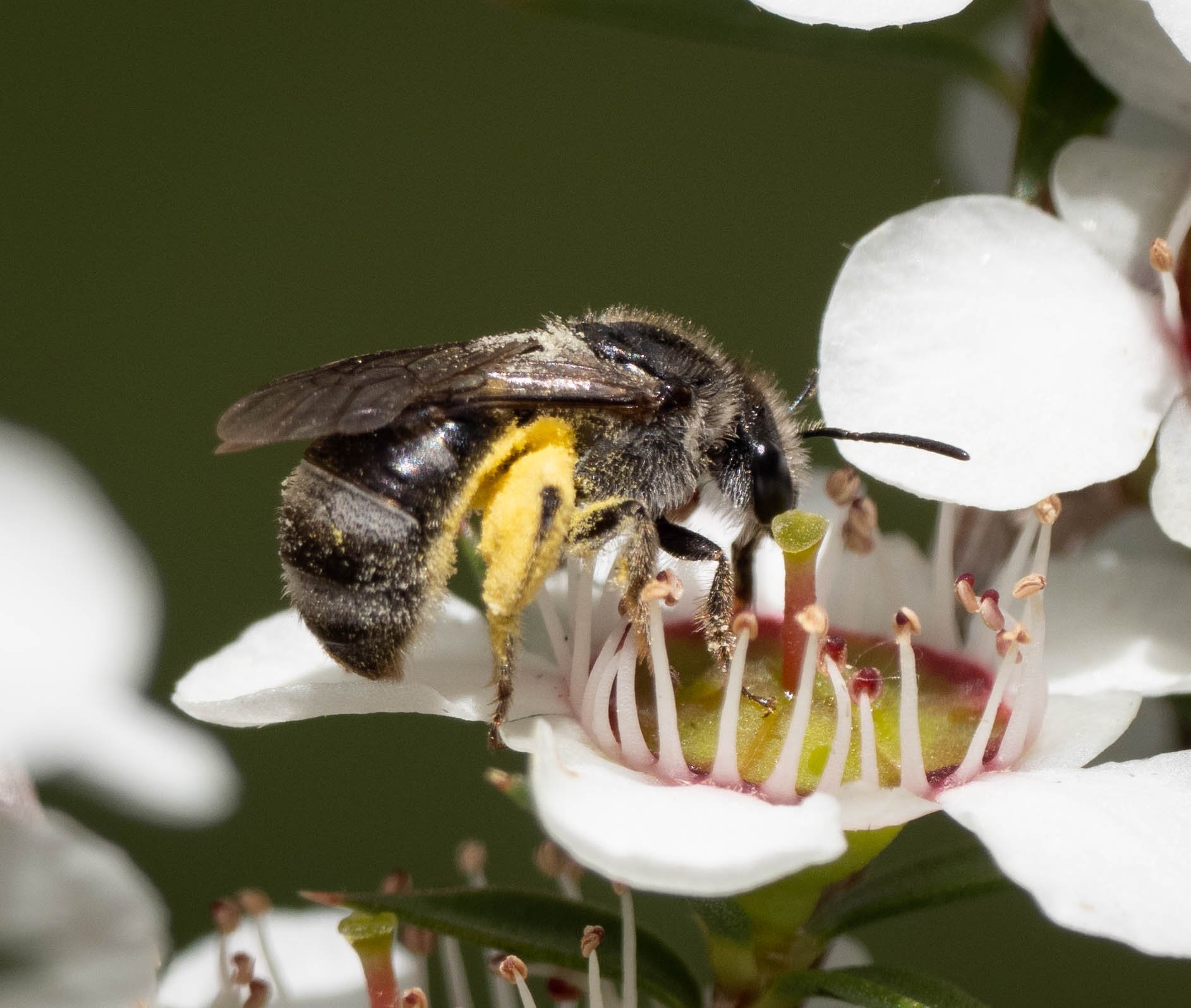
Sweat Bee
Lasioglossum…a rather large bee, about the size of a honeybee. Females collect pollen and hold it in special hairs (scopae) on the hind legs and underside of the abdomen. They are solitary and nest in burrows in the ground. However, several females may share a common entrance to their burrows.

Sweat Bee
Lasioglossum…this photo shows the short tongue (glossa) connected to a long extendible arm, enabling the bee to reach all parts of the flower bowl.

European Honey Bee
Apis mellifera…a large bee, about the same size as the Sweat Bee seen nearby. The hairy eyes are a diagnostic feature of this feral species. Thankfully, we saw few on this teatree bush.

European Honey Bee
Apis mellifera…like the Sweat Bee, the Honey Bee holds its pollen in baskets on the flattened segments of the hind legs. This individual was more intent on nectar, rather than pollen collection - as shown by its bare legs.

Pin-tail Beetle
Mordella…these small beetles were abundant on the teatree flowers, where they were feeding on both nectar and pollen.

Pin-tail Beetle
Mordella…the strongly serrated antennae place these beetles in this genus.

Pin-tail Beetle
Mordella…they were very active - befitting their other common name of tumbling beetles - and flew off quickly if disturbed.

Chafer
Phyllotocus…swarms of these large, slow-moving beetles were found around and over the teatree bush, feeding on both pollen and nectar.

Chafer
Phyllotocus…their large size and rather clumsy movements meant they were continually brushing against the anthers of the flowers. This behaviour, together with their hairy head and pronotum makes them important pollinators.

Chafer
Phyllotocus...this one can be seen taking nectar

Kangaroo Beetle
Mecynodera coxalgica…despite their enlarged hind femora - which lend this species its common name - these beetles can’t jump. Instead they crawl slowly around the teatree flowers, consuming pollen.

Kangaroo Beetle
Mecynodera coxalgica…this shot shows those ‘kangaroo’ legs to good effect.

Kangaroo Beetle
Mecynodera coxalgica…another view of those impressive hind legs. Remember, you can’t jump!

Click Beetle
Click Beetle…searching for pollen. Another potential pollinator, as seen by the grains on its back.

Checkered Beetle
Eleale pulcher…this striking beetle was definitely targetting pollen
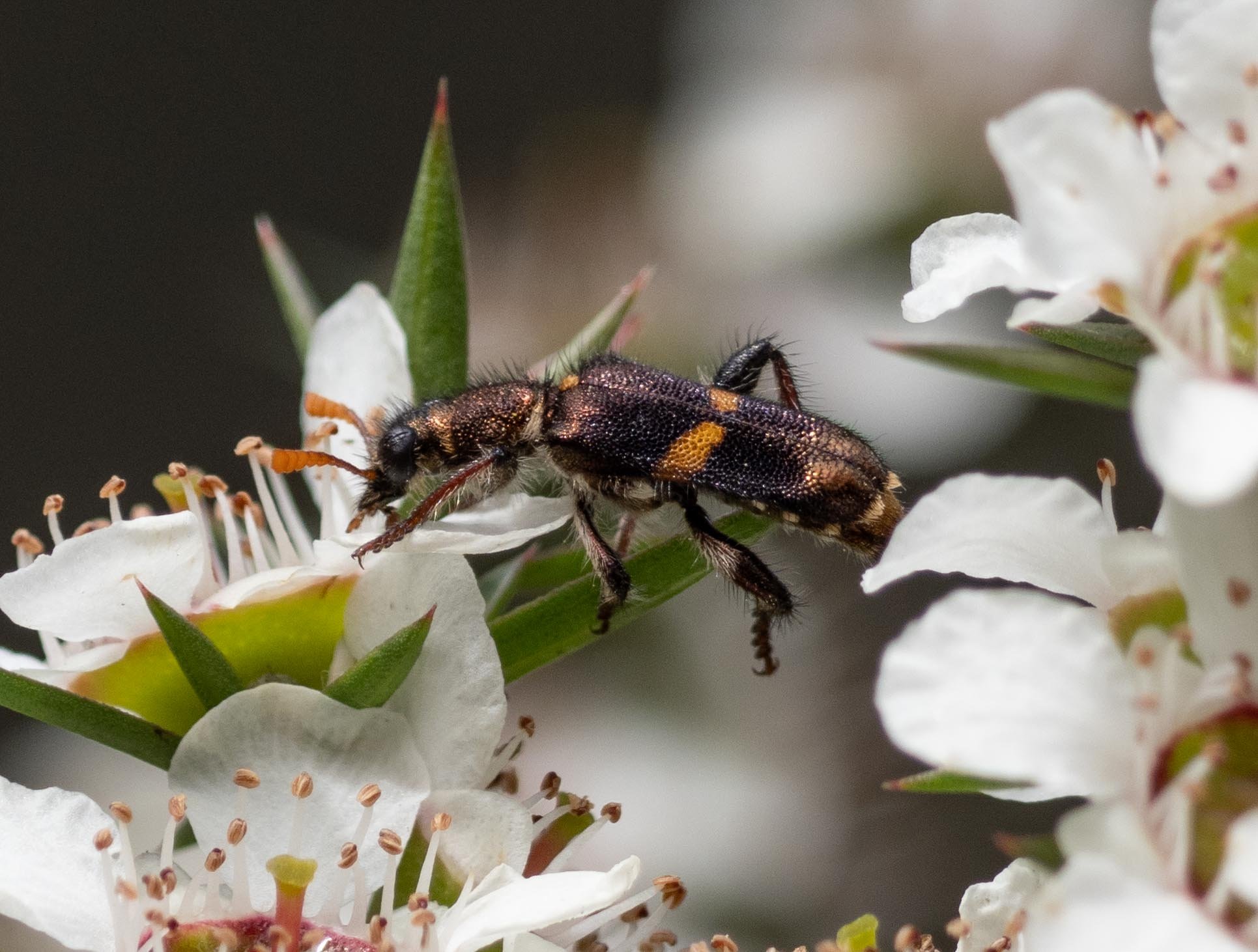
Checkered Beetle
Eleale pulcher…its bold body patterning and colouration deters potential predators.

Punctate Flower Chafer
Neorrhina punctatum…this large, striking flower chafer - like other beetles in this group - is an important pollinator.

Punctate Flower Chafer
Neorrhina punctatum…it is seen here feeding on nectar.

Net-winged Beetle
Net-winged Beetle…advertise their unpleasant taste to birds and other predators with bold colouration.

Bright Copper
Paralucia aurifer…butterflies were infrequent visitors to the teatree flowers. The Bright Copper was one of the few species to make an appearance.

Bright Copper
Paralucia aurifer…a side-on view of the feeding butterfly shows its long proboscis, sucking up nectar from the bowl of the teatree flower.

Lilac Grass-Skipper
Toxidia doubledayi…an occasional visitor to the teatree bush. Its larvae feed on Weeping Grass (Microlaena stipoides), one of our most common grasses. The long proboscis reaches nectar in the floral cup from a distance.

Common Brown Butterfly
Heteronympha merope…the most common butterfly currently in the forest. Its long proboscis is almost overkill for accessing nectar from the expansive teatree flower.
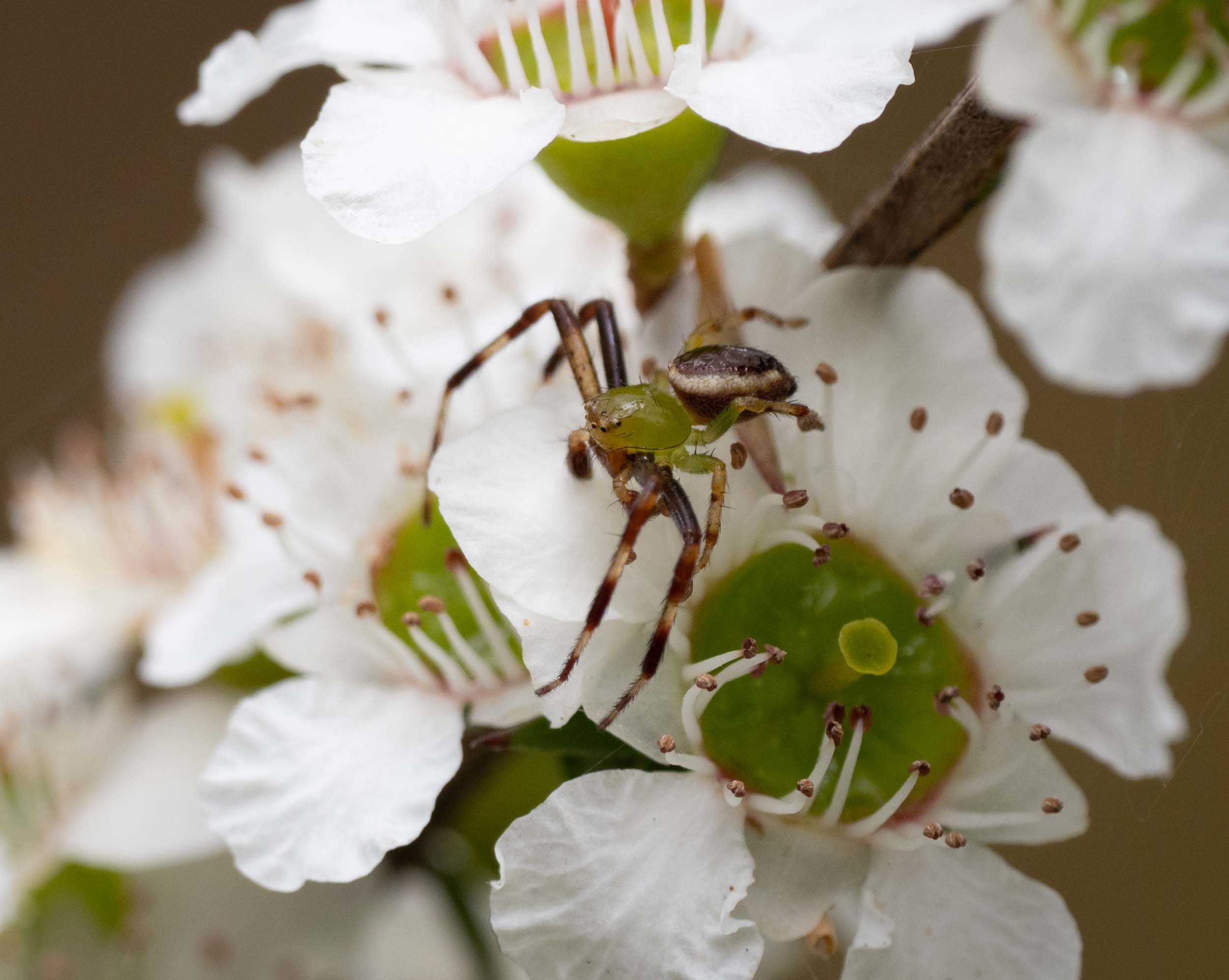
Lozenge-shaped Crab Spider
Australomisidia pilula…this small spider relies on camouflage to avoid detection while sitting still astride a teatree flower. It dashes out quickly to grab an unwary nearby insect.

Lozenge-shaped Crab Spider
Australomisidia pilula…the long legs of the spider enable it to tackle prey much larger than the modest size of its trunk. Its green and brown colouration mimics some of the parts of the flowers.

Bull Ant
Myrmecia…A single ant was seen wandering around the teatree bush, looking for unwary prey.

Wood Cockroach
Wood cockroach…We sighted this small cockroach grazing on the anthers of the teatree flower at night.

Wood Cockroach
Wood Cockroach… probably contributes to pollination of the plant.

Golden-tailed Bull Ant
Myrmecia piliventris…another predator looking for an insect meal on the teatree bush.

Garden Orb Weaver
Hortophora…this small spider had spun its web low down in the teatree bush amongst the flower buds - watching and waiting…

Orb-weaver Spider
Orb-weaver Spider…this predator has already made a successful capture of prey - looks like a bee.




































































